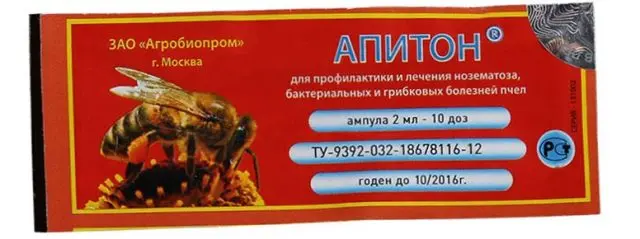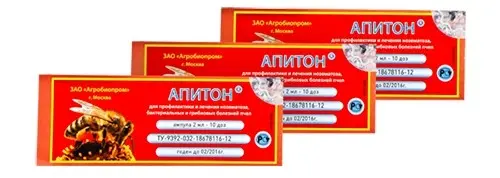Contents
Atipon produced by CJSC “Agrobioprom” is recognized as a reliable tool in the fight against fungal and bacterial diseases in bees. Efficiency has been proven by the professor of the Kuban State Institute L. Ya Moreva. From 2010 to 2013, scientific tests were carried out, as a result of which the drug was recommended for the prevention and treatment of bees.

Application in beekeeping
Nosematosis is considered a dangerous disease in bees. It develops spores of the disease when it enters the body of an insect. Being in the intestine for a long time, the spores turn into parasites that corrode the intestinal mucosa. In bees, the intestinal microflora is destroyed. They wither and die. The pestilence can be massive.
As a rule, the symptoms of the disease become visible at the end of winter. They appear as black streaks on the walls of the hive. If weak and dead bees have been added to the visible signs, then treatment should be started immediately.
Antibiotics are not suitable, as chemical residues remain in honey for a long time. To combat fungal and bacterial diseases, drugs are used that do not harm the human body.
Composition, form of release
Apiton for bees is produced in the form of a liquid. Packaging – glass bottles, 2 ml. They are sealed in blisters. Main active ingredients: extract of propolis, garlic, onion.
Pharmacological properties
Bee colonies are affected by fungal diseases: ascapherosis and aspergillosis. This happens at the beginning of spring. The causes of ailments are cold weather, contaminated food for bees and larvae.
Actions of the preparation:
- normalizes the intestinal microflora;
- destroys nosema;
- increases overall resistance;
- stimulates oviposition;
- actively reacts to causative agents of foul diseases;
- eliminates diarrhea;
- increases the lifespan of the bee.
Instructions for use
Treatment is carried out in the spring. The drug is used as an additive in bee feed. Unpack the product before mixing with syrup. Apiton is poured into feeders or into free combs. They are specially installed in the brood zone of the nest. The dosage of the drug cannot be increased.
Dosage, application rules
Apiton is given to bees in the form of top dressing. A syrup is needed, which is prepared from sugar and water in proportions of 1: 1. 5 ml of the drug is poured into 2 liters of warm syrup. Single serving – 0,5 liters of solution per hive. In total, there will be 3 dressings with an interval of 3-4 days.
Side effects, contraindications, restrictions on use
When using Apiton according to the instructions, side effects and contraindications for bees have not been established. Honey from bees treated with the drug is allowed to be consumed on a general basis.
While working with the drug, you should follow the rules of safety and personal hygiene. It is forbidden to smoke, drink and eat during the process. It is necessary to unpack the Apiton package immediately before the procedure. After washing your hands with soap. If the drug gets on the mucous membrane, it is necessary to rinse the damaged area with water. If allergic reactions occur, it is important to seek immediate medical attention. You must have the packaging or instructions from Apiton with you.
Shelf life and storage conditions
Apiton for bees is suitable for use within 3 years from the date of manufacture. Dispose of the drug after the expiration date.
Long-term storage of the chemical agent is possible in the sealed packaging of the manufacturer. It is not allowed to save Apiton for bees in the open state. It is important to exclude contact of the drug with food and feed. Restrict access for children. The storage place must be dry, without direct sunlight. The temperature of the storage room is + 5-25 °С, the humidity level is not more than 50%. It is released without a veterinarian prescription.
Conclusion
Apiton is a safe medicine that helps to overcome nosematosis and other diseases of bees. Has no contraindications and side effects. The drug is harmless to humans. The honey of insects undergoing treatment does not contain harmful substances.










